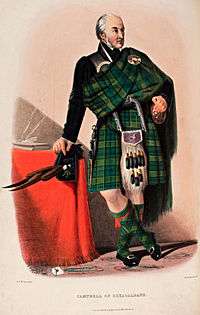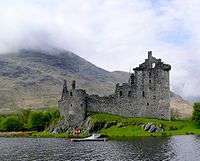Earl of Breadalbane and Holland
Earl of Breadalbane and Holland is a title in the Peerage of Scotland. It was created in 1681 for Sir John Campbell, 5th Baronet, of Glenorchy, who had previously been deprived of the title Earl of Caithness. He, as a principal creditor, had acquired the estates of George Sinclair, 6th Earl of Caithness who had died heavily in debt and without issue in 1670. Campbell was consequently created Earl of Caithness in 1673, but after much litigation and even bloodshed, George Sinclair of Keiss (died 1698), second son of George, 5th Earl of Caithness (died 1643), recovered the estates, and successfully petitioned parliament regarding the earldom, which was removed from Campbell. Sinclair's title was finally restored to him in 1681. Deprived by parliament of the Caithness earldom, Sir John Campbell was created Lord Glenorchy, Benederaloch, Ormelie and Weick, Viscount of Tay and Paintland, and Earl of Breadalbane and Holland on 13 August 1681, with the precedency of the former patent and with the power to nominate any of his sons by his first wife to succeed him. The titles were created with remainder to the heirs male of the son chosen to succeed him, failing which to the heirs male of his body, failing which to his own heirs male, failing which to his heirs whatsoever. The "of Holland" part of the title derived from the fact that Campbell was the husband of Lady Mary Rich, daughter of Henry Rich, 1st Earl of Holland (see Earl of Holland).
| Earldom of Breadalbane and Holland | |
|---|---|
.svg.png) Arms of the 6th Earl of Breadalbane, 1868 (Lyon Register, vol. 8, p. 13) | |
| Creation date | 13 August 1681 |
| Monarch | Charles II |
| Peerage | Peerage of Scotland |
| First holder | John Campbell, 1st Earl of Breadalbane and Holland |
| Last holder | John Campbell, 10th Earl of Breadalbane and Holland |
| Present holder | Dormant |
| Remainder to | Heirs male of the son chosen to succeed him, failing which to the heirs male of his body, failing which to his own heirs male, failing which to his heirs whatsoever |
| Subsidiary titles | Lord Glenorchy, Benederaloch, Ormelie and Weick Viscount of Tay and Paintland |
| Former seat(s) | Taymouth Castle |


The member of a junior branch of Clan Campbell, Breadalbane was a descendant of Sir Colin Campbell, 1st of Glenorchy (died 1475), the son of Duncan Campbell, 1st Lord Campbell by his second wife Margaret Stewart and the half-brother of Archibald Campbell, Master of Campbell, ancestor of the Dukes of Argyll. Colin Campbell was granted Glenorchy and other lands by his father and built Kilchurn Castle on Loch Awe in Argyll. King James III knighted him and granted him land around Loch Tay in thanks for hunting down the local earls who had assassinated James II, and to end the power vacuum in the surrounding region that had resulted when they were executed. The land around Loch Tay formed Breadalbane, creating the association between the area and Colin Campbell's descendants.
His son Sir Duncan Campbell of Glenorchy was one of the many Scottish nobles killed at the Battle of Flodden in 1513. Sir Duncan's great-grandson and namesake Duncan Campbell, known as "Black Duncan", represented Argyllshire in the Scottish Parliament. He was knighted in 1590 and created a baronet, of Glenorchy in the County of Perth, in the Baronetage of Nova Scotia in 1625. His elder son, Sir Colin, the second Baronet, died childless and was succeeded by his younger brother, Sir Robert, the third Baronet. He represented Argyllshire in the Scottish Parliament. He was succeeded by his son, Sir John, the fourth Baronet. He also represented Argyllshire in Parliament. He was succeeded by his son by his first marriage, the aforementioned Sir John Campbell, the fifth Baronet, who was created Earl of Breadalbane and Holland in 1681.
Lord Breadalbane and Holland's elder son Duncan Campbell, styled Lord Ormelie, was overlooked for the succession (owing to his "incapacity") and died childless in 1727. Breadalbane nominated his younger son John as his successor, and he consequently succeeded in the titles on his father's death in 1717. He sat in the House of Lords as a Scottish Representative Peer between 1736 and 1747. He was succeeded by his son, John, the third Earl. He was a prominent statesman. Lord Breadalbane and Holland married as his first wife Lady Amabel Grey, daughter of Henry Grey, 1st Duke of Kent. Their daughter Lady Jemima Campbell succeeded her maternal grandfather as Marchioness Grey in 1740. Through Lady Jemima Lord Breadalbane was a great-grandfather of Prime Minister Lord Goderich. Lord Breadalbane outlived both his only son by his first wife and his two sons by his second marriage to Arabella Pershall. On his death in 1782 the male line of the first Earl failed.
The late Earl was succeeded by his kinsman, John Campbell, who became the fourth Earl. He was the great-grandson of Colin Campbell of Mochaster, younger son of Sir Robert Campbell, 3rd Baronet, and uncle of the first Earl. He was a Lieutenant-General in the British Army and sat in the House of Lords as a Scottish Representative Peer between 1784 and 1806. The latter year he was created Baron Breadalbane, of Taymouth Castle in the County of Perth, in the Peerage of the United Kingdom, which entitled him to an automatic seat in the House of Lords. In 1831 he was further honoured when he was made Earl of Ormelie and Marquess of Breadalbane in the Peerage of the United Kingdom. He was succeeded by his only son, the second Marquess. He was a Liberal politician and served twice as Lord Chamberlain of the Household. He was childless and the barony of Breadalbane, earldom of Ormelie and marquessate became extinct on his death in 1862.
He was succeeded in the Scottish titles by his kinsman, John Campbell, the sixth Earl. He was the grandson of James Campbell, great-great-grandson of William Campbell of Glenfalloch (died 1648), brother of the aforementioned Colin Campbell of Mochaster. On his death the titles passed to his son, the seventh Earl. He was a Liberal politician and notably served as Treasurer of the Household and Lord Steward of the Household. In 1873 he was created Baron Breadalbane, of Kenmure in the County of Perth, in the Peerage of the United Kingdom, which entitled him to an automatic seat in the House of Lords. In 1885 he was made Earl of Ormelie, in the County of Caithness, and Marquess of Breadalbane in the Peerage of the United Kingdom. He was childless and these titles consequently became extinct on his death in 1922. He was succeeded in the Scottish titles by his nephew, Iain Campbell, the eighth Earl. He was the son of Captain the Honourable Ivan Campbell, second son of the sixth Earl. The eighth Earl died at an early age in 1923, only a year after succeeding his uncle. He was succeeded by his kinsman, Charles Campbell, the ninth Earl. He was the son of Major-General Charles William Campbell of Borland, grandson of John Campbell of Borland, younger brother of the aforementioned James Campbell, grandfather of the sixth Earl. The ninth earl sat in the House of Lords as a Scottish Representative Peer between 1924 and his death in 1959. He was succeeded by his only son, John, the tenth Earl. He was severely wounded while serving with the Black Watch in the Second World War. He died childless in 1995 when the titles became dormant.
Hungarian-born Huba Campbell (born 1945), a third cousin once removed from the tenth Earl, has petitioned the Lord Lyon for recognition of his right to the Earldom of Breadalbane and Holland, together with the subsidiary titles, and to the undifferenced arms, this as the great-great-grandson of George Campbell, brother of George Andrew Campbell (1791–1852), brother of Charles William Campbell of Borland, grandfather of the ninth Earl.[1] A British aristocrat, Sir Lachlan Campbell, 6th Baronet, also claims the titles. He is a descendant of Sir Guy Campbell, 1st Baronet, grandson of John Campbell, son of the Honourable Colin Campbell, the son of first Earl by his second marriage to Lady Mary Campbell. Sir Lachlan however, is apparently unable to succeed because his ancestor John Campbell was illegitimate (see Campbell baronets, of St Cross Mede, for further history of this branch of the family).
The main seat of the Earls of Breadalbane and Holland from the early 19th century was the vast Taymouth Castle in Scotland, which was sold by the ninth Earl shortly after the end of the First World War.
The father of the Scottish writer Fred Urquhart was chauffeur to the Earl in the early twentieth century, and Urquhart's novel Palace of Green Days (1979) draws on his childhood memories of this.[2]
Campbell baronets, of Glenorchy (1625)
- Sir Duncan Campbell, 1st Baronet (c. 1550 – 1631)
- Sir Colin Campbell, 2nd Baronet (c. 1577 – 1640)
- Sir Robert Campbell, 3rd Baronet (c. 1580 – c. 1650)
- Sir John Campbell, 4th Baronet (c. 1615 – c. 1670)
- Sir John Campbell, 5th Baronet (1635–1717) (created Earl of Breadalbane and Holland in 1681)
Earls of Breadalbane and Holland (1681)
- John Campbell, 1st Earl of Breadalbane and Holland (1635–1717)
- Duncan Campbell, Lord Ormelie (c. 1660 – 1727)
- John Campbell, 2nd Earl of Breadalbane and Holland (1662–1752)
- John Campbell, 3rd Earl of Breadalbane and Holland (1692–1782)
- Hon. Henry Campbell (c. 1721 – 1727)
- Hon. George Campbell (died 1744)
- John Campbell, Lord Glenorchy (1738–1771)
- John Campbell, 4th Earl of Breadalbane and Holland (1762–1834) (created Marquess of Breadalbane in 1831)
Marquesses of Breadalbane; First creation (1831)
| Marquessate of Breadalbane Extinct | |
|---|---|
| Creation | 1831 (first creation) 1885 (second creation) |
| Monarch | William IV (first creation) Victoria (second creation) |
| Peerage | Peerage of the United Kingdom |
| First holder | John Campbell, 1st Marquess of Breadalbane |
| Last holder | Gavin Campbell, 1st Marquess of Breadalbane |
| Subsidiary titles | Earl of Ormelie |
| Extinction date | 1862 (first creation) 1922 (second creation) |
| Former seat(s) | Taymouth Castle |
- John Campbell, 1st Marquess of Breadalbane (1762–1834)
- John Campbell, 2nd Marquess of Breadalbane (1796–1862)
Earls of Breadalbane and Holland (1681; Reverted)
- John Alexander Gavin Campbell, 6th Earl of Breadalbane and Holland (1824–1871)
- Gavin Campbell, 7th Earl of Breadalbane and Holland (1851–1922) (created Marquess of Breadalbane in 1885)
Marquesses of Breadalbane; Second creation (1885)
- Gavin Campbell, 1st Marquess of Breadalbane (1851–1922)
Earls of Breadalbane and Holland (1681; Reverted)
- Iain Edward Herbert Campbell, 8th Earl of Breadalbane and Holland (1885–1923)
- Charles William Campbell, 9th Earl of Breadalbane and Holland (1889–1959)
- John Romer Boreland Campbell, 10th Earl of Breadalbane and Holland (1919–1995)
| Family tree | ||||||||||||||||||||||||||||||||||||||||||||||||||||||||||||||||||||||||||||||||||||||||||||||||||||||||||||||||||||||||||||||||||||||||||||||||||||||||||||||||||||||||||||||||||||||||||||||||||||||||||||||||||||||||||||||||||||||||||||||||||||||||||||||||||||||||||||||||||||||||||||||||||||||||||||||||||||||||||||||||||||||||||||||||||||||||||||||||||||||||||||||||||||||||||||||||||||||||||||||||||||||||||||||||||||||||||||||||||||||||||||||||||||||||||||||||||||||||||||||||||||||||||||||||||||||||||||||||||||||||||||||||||||||||||||||||||||||||||||||||||||||||||||||||||||||||||||||||||||||||||||||||||||||||||||||||||||||||||||||||||||||||||||||||||||||||||||||||||||||||||||||||||||||||||||||||||||||||||||||||||||||||||||||||||||||||||||||||||||||||||||||||||||||||||||||||||||||||||||||||||||||||||||||||||||||||||||||||||||||||||||||||||||||||
|---|---|---|---|---|---|---|---|---|---|---|---|---|---|---|---|---|---|---|---|---|---|---|---|---|---|---|---|---|---|---|---|---|---|---|---|---|---|---|---|---|---|---|---|---|---|---|---|---|---|---|---|---|---|---|---|---|---|---|---|---|---|---|---|---|---|---|---|---|---|---|---|---|---|---|---|---|---|---|---|---|---|---|---|---|---|---|---|---|---|---|---|---|---|---|---|---|---|---|---|---|---|---|---|---|---|---|---|---|---|---|---|---|---|---|---|---|---|---|---|---|---|---|---|---|---|---|---|---|---|---|---|---|---|---|---|---|---|---|---|---|---|---|---|---|---|---|---|---|---|---|---|---|---|---|---|---|---|---|---|---|---|---|---|---|---|---|---|---|---|---|---|---|---|---|---|---|---|---|---|---|---|---|---|---|---|---|---|---|---|---|---|---|---|---|---|---|---|---|---|---|---|---|---|---|---|---|---|---|---|---|---|---|---|---|---|---|---|---|---|---|---|---|---|---|---|---|---|---|---|---|---|---|---|---|---|---|---|---|---|---|---|---|---|---|---|---|---|---|---|---|---|---|---|---|---|---|---|---|---|---|---|---|---|---|---|---|---|---|---|---|---|---|---|---|---|---|---|---|---|---|---|---|---|---|---|---|---|---|---|---|---|---|---|---|---|---|---|---|---|---|---|---|---|---|---|---|---|---|---|---|---|---|---|---|---|---|---|---|---|---|---|---|---|---|---|---|---|---|---|---|---|---|---|---|---|---|---|---|---|---|---|---|---|---|---|---|---|---|---|---|---|---|---|---|---|---|---|---|---|---|---|---|---|---|---|---|---|---|---|---|---|---|---|---|---|---|---|---|---|---|---|---|---|---|---|---|---|---|---|---|---|---|---|---|---|---|---|---|---|---|---|---|---|---|---|---|---|---|---|---|---|---|---|---|---|---|---|---|---|---|---|---|---|---|---|---|---|---|---|---|---|---|---|---|---|---|---|---|---|---|---|---|---|---|---|---|---|---|---|---|---|---|---|---|---|---|---|---|---|---|---|---|---|---|---|---|---|---|---|---|---|---|---|---|---|---|---|---|---|---|---|---|---|---|---|---|---|---|---|---|---|---|---|---|---|---|---|---|---|---|---|---|---|---|---|---|---|---|---|---|---|---|---|---|---|---|---|---|---|---|---|---|---|---|---|---|---|---|---|---|---|---|---|---|---|---|---|---|---|---|---|---|---|---|---|---|---|---|---|---|---|---|---|---|---|---|---|---|---|---|---|---|---|---|---|---|---|---|---|---|---|---|---|---|---|---|---|---|---|---|---|---|---|---|---|---|---|---|---|---|---|---|---|---|---|---|---|---|---|---|---|---|---|---|---|---|---|---|---|---|---|---|---|---|---|---|---|---|---|---|---|---|---|---|---|---|---|---|---|---|---|---|---|---|---|---|---|---|---|---|---|---|---|---|---|---|---|---|---|---|---|---|---|---|---|---|---|---|---|---|---|---|---|---|---|---|---|---|---|---|---|---|---|---|---|---|---|---|---|---|---|---|---|---|---|---|---|---|---|---|---|---|---|---|---|---|---|---|---|---|---|---|---|---|---|---|---|---|---|---|---|---|---|---|---|---|---|---|---|---|---|---|---|---|---|---|---|---|---|---|---|---|---|---|---|---|---|---|---|---|---|---|---|---|---|---|---|---|---|---|---|---|---|---|---|---|---|---|---|---|---|---|---|---|---|---|---|---|---|---|---|---|---|---|---|---|---|---|---|---|---|---|---|---|---|---|---|---|---|---|---|---|---|---|---|---|---|---|---|---|---|---|---|---|---|---|---|---|---|---|---|---|---|---|---|---|---|---|---|---|---|---|---|---|---|---|---|---|---|---|---|---|---|---|---|---|---|---|---|---|---|---|---|---|---|---|---|---|---|---|---|---|---|---|---|---|
| ||||||||||||||||||||||||||||||||||||||||||||||||||||||||||||||||||||||||||||||||||||||||||||||||||||||||||||||||||||||||||||||||||||||||||||||||||||||||||||||||||||||||||||||||||||||||||||||||||||||||||||||||||||||||||||||||||||||||||||||||||||||||||||||||||||||||||||||||||||||||||||||||||||||||||||||||||||||||||||||||||||||||||||||||||||||||||||||||||||||||||||||||||||||||||||||||||||||||||||||||||||||||||||||||||||||||||||||||||||||||||||||||||||||||||||||||||||||||||||||||||||||||||||||||||||||||||||||||||||||||||||||||||||||||||||||||||||||||||||||||||||||||||||||||||||||||||||||||||||||||||||||||||||||||||||||||||||||||||||||||||||||||||||||||||||||||||||||||||||||||||||||||||||||||||||||||||||||||||||||||||||||||||||||||||||||||||||||||||||||||||||||||||||||||||||||||||||||||||||||||||||||||||||||||||||||||||||||||||||||||||||||||||||||||
See also
References
- Daily Telegraph Hungarian Claims Scottish Earldom
- "Papers of Fred Urquhart". Jisc Archives Hub. Retrieved 27 September 2017.
- Brown, Peter, publisher, The Peerage of Scotland, Edinburgh, 1834, pps: 91–2 and 141.